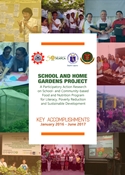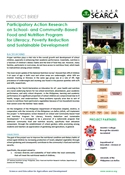Participatory Action Research on School- and Community-Based Food and Nutrition Program for Literacy, Poverty Reduction and Sustainable Development
Background
Proper nutrition plays a vital role in the overall growth and development of school children, especially in enhancing their academic performance. Essentially, nutrition is a function of children's dietary habits and the kind of food they eat. However, many families, particularly in rural areas, do not have access to nutritious food, which leads to malnutrition among school children.
The most recent update of the National Nutrition Survey1 showed that 29% of children 5-10 years of age in both rural and urban areas are underweight, while 30% are stunted. Wasting or thinness in the same age group was at a rate of 9%. High prevalence of underweight and stunting was found in the poorest quintiles with 42% and 48%, respectively.
According to the 'World Declaration on Education for All', poor health and nutrition are crucial underlying factors for low school enrolment, absenteeism, poor academic performance, and early school dropouts. In the Philippines, learning and academic performance of a significant proportion of school children are compromised due to ill health, hunger, and undernutrition. These problems typically arise due to lack of access to nutritious food (particularly vegetables) because of low household incomes that cannot cover the families' basic needs.
On the instigation of the Philippines Department of Education (DepEd), SEARCA, in cooperation with the University of the Philippines Los Baños (UPLB), will implement the project "A Participatory Action Research on School and Community-based Food and Nutrition Program for Literacy, Poverty Reduction and Sustainable Development." It is envisaged to be a precursor of a nationwide program that addresses community food and nutrition security, specifically food utilization component, through the establishment of school gardens while promoting among students and teachers an appreciation of gardening and agriculture, in general.
Objectives
The goal of the project was to improve the nutritional condition and dietary habits of school-aged children by increasing production of locally adapted vegetables through school gardening and consequently contribute to the community's food and nutrition security.
Specifically, the project aimed to:
- Increase diversity and availability of food within the local community that will meet the nutritional needs of children;
- Increase knowledge and improve skills of students and teachers on food production and nutrition through experiential learning activities; and
- Reduce food expenses, create savings, and provide an alternative source of income for families.
Focus Areas
- Educational – Increase the relevance and quality of education of schoolchildren through experiential learning activities in food production and nutrition
- Nutritional – Increase diversity and availability of food within the local community that will meet the nutritional needs of children;
- Economic (Long-term) – Reduce families' food expenses, create savings, and provide an alternative source of income for families to alleviate poverty.
Implementation
The Project was implemented from January 2016 to June 2017. Implementation was subdivided into three (3) phases. The preliminary phase included the selection of pilot schools, conduct of planning workshop, assessment of existing school gardens, baseline study on the nutritional status of children, preparation of garden plans, curricula review, and acquisition of garden inputs and structures.
Phase 2 involved the establishment and maintenance of the school gardens, development of lesson plans integrating agriculture and nutrition concepts to the current curriculum, organization of core groups and establishment of linkages and cross-visits, and monitoring of project sites.
Phase 3 included the following activities: harvesting of produce, assessment of garden produce and utilization, endline study on the nutritional status of children, awarding of outstanding school garden, development of upscaling strategy, and exchange learning visit to Indonesia counterpart.
Key Accomplishments
Specific Objective 1. Nutrition
- Improved Nutrition, Knowledge, Attitudes, and Practices (KAP) towards Vegetable Consumption and Production. Baseline and endline data collection on children's nutritional status and KAP have been conducted.
Specific Objective 2. Education
- The six pilot schools have enhanced their respective existing gardens following the concepts of edible landscaping and organic agriculture.
- One hundred and twenty-five (125) lesson plans integrating the concepts of nutrition, organic agriculture, climate change mitigation and adaptation, and solid waste management were prepared by Grade 4 and Grade 7 Science, Mathematics, English, Edukasyong Pantahanan at Pangkabuhayan (EPP) (Home Economics) and Technology and Livelihood Education (TLE) teachers.
Specific Objective 3. Economics
- Improved Supply and Quality of Fresh Vegetables for the School-based Feeding Program
Additional Outputs and Outcomes
- Capability Enhancement of Teachers
- On-line Information Exchange among School Partners
- Local Support to School and Home Gardens through Partnership of Schools with their Local Government and other Stakeholders
- Sustaining and Scaling up Project Success through Intra- and Inter-Networking
- Program Sustainability Through Policy Formulation
____________________
18th National Nutrition Survey: Philippines. 2013. Food and Nutrition Research Institute. Department of Science and Technology.


